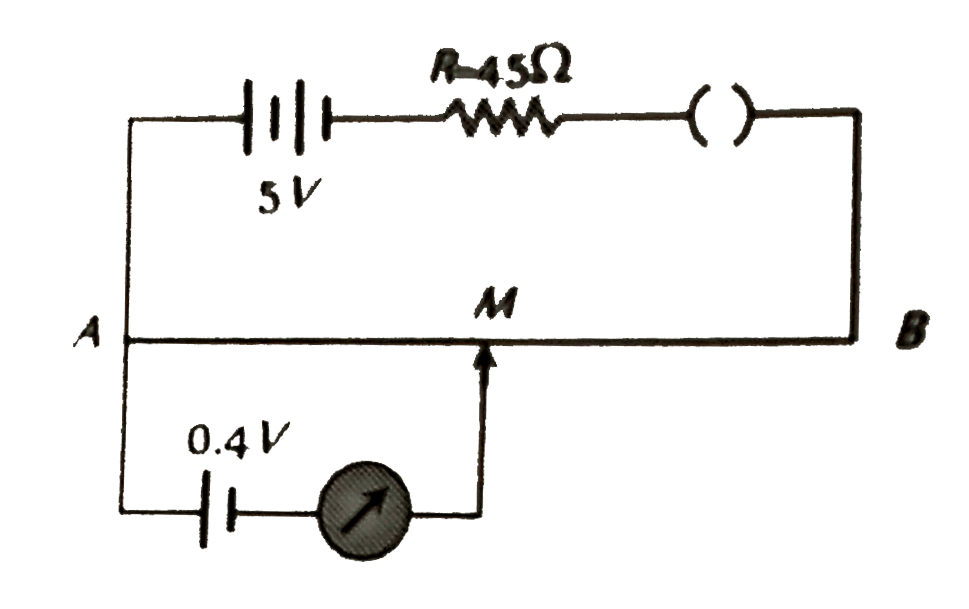
In an experiment with a potentiometer, VB=10V. R is adjusted to the 50Ω (figure). A student wanting to measure voltage E1 to a battery (approx. 8V) finds no null point possible. He then diminishes R to 10Ω and is able to locate the null point ont he last (4th) segment of the potentiometer. find the resistance of the potentiometer wire and potential drop per unit length across the wire in the second case.
Let R' be the resistance of the potentiometer wire.
Effective resistance of potentiometer and variable resistor (R=50Ω) is given by =50Ω+R' Effective voltage applied across potentiometer=10V.
the current through the main circuit,
I=V50Ω+R=1050Ω+R
Potential difference across wire of potentiometer
IR'=10R'50Ω+R
Since with 50Ω resistor, null point is not obtained it's possible only when
10×R'50+R=1050Ω+R
Potential difference across wire of potentiometer,
IR'=10R'50Ω+R
Since with 50Ω resistor, null point is not obtained it's possible only when
10×R'50+R<8
⇒10R<400+8R'
2R'<400 or R'<200Ω
Similarly with 10Ω resistor, null point is obtained its possible only when
10×R'10+R'>8
⇒2R'>80
R'>40
10×34R'10+R'<8
⇒7.5R'<80+8R'
R'>160
⇒160<R'<200
Any R' between 160Ωand200Ω will achieve.
Since, the null point on the last (4th) segment of the potentiometer, therefore potential drop this imply that potential gradient
k×400cm>8V
or k×4m>8V
Similarly, potential drop across 300 cm wire <8V
k×100cm<8V
or k×103m<8V
k<223V/m
Thus, 223V/m>k>2V/m
Topper's Solved these Questions
Similar Questions
In an experiment with a potentiometer, VB=10V. R is adjusted to be 50Ω (see figure) . A student wanting to measure voltage E1 of a battery ( approx. 8V) finds no null point on the last (4th) segment of the potentiometer.Find the resistance of the potentiometer wire and potential drop per unit length across the wire in the second case.

View SolutionThe given potentiometer has its wire of resistance 10Ω When the sliding contact is in the middle of the potentiometer wire, the potential drop across 2Ω resistor is :

View Solution
Knowledge Check
If the length of the potentiometer wire is doubled, the sensitivity for obtaining null point will –
AincreaseBremain unchangedCdecreaseDuncertainIn given figure, the potentiometer wire AB has a resistance of 5Ω and length 10 m . The balancing length AM for the emf of 0.4 V is
 A0.4mB4mC0.8mD8m
A0.4mB4mC0.8mD8mA 2 V battery, a 990Ω resistor and a potentiometer of 2 m length, all are connected in series of the resistance of potentiometer wire is 10Ω, then the potential gradient of the potentiometer wire is
A0.05Vm−1B0.5Vm−1C0.01Vm−1D0.1Vm−1
Potentiometer wire of length 1m is connected in series with 490Ω resistance and 2V battery. If 0.2mVcm is the potential gradient, then resistance of the potentiameter wire is approximately
View SolutionA potentiometer wire has a length of 4 and a resistance of 8 ohm. It is connected in series with a cell of e.m.f. 2 V and internal resistance 2 ohm. The potential drop per unit length of the wire is
View SolutionA cell of e.m.f. 2 V and negligible internal resistance is connected to a potentiometer wire of resistance 10Ω and length 4 m. The potential difference per unit length (potential gradient ) of the wire is
View SolutionA battery of emf 26V and internal resistance 0.4 ohm is connected to a resistance of 10ohm and a potentiometer wire of length 10m. What is the potential gradient on the wire if the resistance of the potentiometer wire is 5 ohm –
View SolutionIf the length of potentiometer wire is increased, then the accuracy in the determination of null point
View Solution
